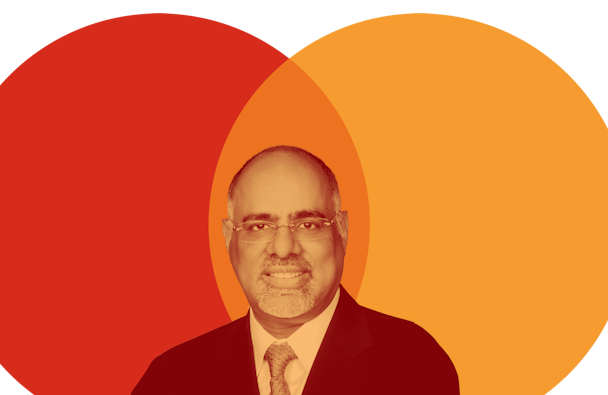3 actionable insights with… Mastercard's Raja Rajamannar
The Drum’s 3 Actionable Insights series asks top industry leaders to offer recommendations for action that our readers should take immediately. This week, Mastercard chief marketer Raja Rajamannar discusses the value of talent, job rotations and more.

Mastercard chief marketer Raja Rajamannar says marketing is in the midst of an existential crisis
At the moment there are a great many of opposing dynamics in place. There is an industry-wide need for talent, but marketing is often viewed by college students as a con job. There is pressure for marketers to prove their value to the C-suite, but at the same time their skills will be more needed than ever as we come out of the pandemic. What should we make of it all? Mastercard chief marketer Raja Rajamannar offer his top three actions.
1. Recruit and develop ‘da Vinci-type marketers’ beginning at the college level
Talent is critical at this point in time, because marketing has become incredibly complex. Traditionally, classically trained marketers were qualitative. It was about creativity, intuition, judgment, stuff like that. But there’s so much more science, technology and data that has come into marketing, that many of marketers are finding themselves hopelessly out of their depth.
And when a question is asked by the chief financial officer (CFO) or the chief executive like ‘what are we getting in return for the are billions of dollars you’re spending on your marketing campaigns?’ They expect a business answer, but the marketers typically give a marketing answer, which to the CFO sounds like fluff.
That’s a big disconnect so marketers have to move quickly. They need to broaden their skill sets to encompass the data, the technology and the finance aspects. I call these the da Vinci-type marketers. They use both the right brain and left brain. Marketers need to do that. Marketing in the future is not going to be a functional specialization. It is about general management, with a deep understanding of marketing. Finding such talent is going to be critical.
It’s actually not an overnight fix. It’s a journey. You have to equip marketers to become general managers. One stream of activity will be to find people who have the natural talent, whose approach is left brain and right brain, starting at the colleges.
But people who have got those kinds of skills don’t want to join marketing. The perception of marketing, in many of the colleges, is that it is a con game. In fact, the ANA has done the research over two-year span, that shows many students have no clue about marketing. So, you’re stuck because the best of the students won’t gravitate to marketing in this day and age. When I graduated 35 years back, marketing was the number one field that the best students wanted to go into.
Today, they want to go and start their own company. They want to go to Silicon Valley, or they want to join an investment bank for the money. Marketing doesn’t appear anywhere in the top rankings. So, we need to get work with the universities, work with the colleges, work with the professors to really bring back the glory of marketing and tell students what marketing does. What the possibilities are. How exciting it is now. Very few fields are as exciting as marketing.
2. Enforce job rotations for marketers within your company
For existing people in the company, you need to really retrain them. There are people, for example, who want to stay lifelong in marketing – you should encourage them to move out. Go and spend time in sales, finance, other areas and then come back to marketing as a well-rounded person. Job rotations are going to be critical.
At Mastercard, we created an exercise called ‘the competencies for the immediate future.’ We started putting training programs in place for our people either in the virtual classroom, or we invite some industry experts to come in and teach us, it’s a whole combination. It’s a big area of priority to train and equip and give them the opportunity to learn.
Likewise, people who have never been in marketing, get them into marketing. Let them spend some time in marketing so they can understand it. Either they will love marketing and they will have the competencies needed and can continue on and become a general manager right away. Or they will go back and become brand ambassadors for marketing for the rest of the company. It will be a cultural shift.
The other option is to keep getting some of the same people who are moving from company-to-company for higher and higher pay. This isn’t going to create the industry change required. You need to cultivate your talent.
3. Fight for your seat at the table, no matter what your ‘marketing’ title is and if it doesn’t happen, move on
From marketing perspective there is quite a major crisis of confidence and an existential threat. Many chief marketing officer roles have been eliminated. These roles have not been eliminated by companies in some obscure industries, but at very sophisticated consumer marketing companies, packaged goods companies. Examples would be Johnson and Johnson or Hershey’s. Iconic companies are moving away from the chief marketing officer role. Instead, they are bringing in chief growth officer, chief revenue officer, chief customer officer, all kinds of other officers.
Marketing is becoming highly fragmented. Look at the classical definition of marketing from Philip Kotler about the four Ps of marketing (product, price, place, promotion.) Today, marketing doesn’t handle product in most of the companies. Marketing doesn’t handle any pricing and at most of the companies, marketing doesn’t handle place which is logistics in most cases. They are barely hanging on to promotions, at best. That is only a part of the ecosystem. Marketing has to regain its gravitas, its stature, and its place back at the table of the CEO. These are the things that I’m grappling with not only as chief marketing officer at Mastercard, but also as the president of the World Federation of Advertisers which has got the membership of CMOs from most of the major companies. We are seeing an industry-wide phenomenon.
At the same time, companies will be under more and more pressure tomorrow than they are today. Technology and data are leveling of the playing field. The same technology, the same data is available to anyone, not just large companies. Even tiny startups can now deploy the latest and the greatest technologies, without investing big amounts because everything is available on a pay-as-you-go basis.
For a company to differentiate itself, to stay ahead of the pack, they need marketing. So, the demand for marketing will actually go up. Because you cannot win in the marketplace by constantly cutting price or modifying your product. You need to get into the hearts and minds of consumers, which is what marketing is all about and marketers do it best. Now the key thing is, if an existing company does not value the marketing talent that they have. Marketers will have no choice but to leave. That may result in churn. On the other hand, the enlightened companies that realize the value of marketing will hold onto their marketers in every which way possible.
Net-net, when we come out of Covid-19 my prognosis is that marketing spending will go up across industries. Every company has pulled back. As an industry we pulled marketing dollars back by almost 30% last year. That’s going to come roaring back.
I think you will see a good amount of churn. Typically, the average tenure of the chief marketer has been between three and four years. We currently have a high percentage of CMOs who have spent more than three years at their current companies. The marketplace is ripe for churn. Companies will need to do a little soul searching about everything that they are doing when it comes to their marketing and marketing talent.
For more, check out Rajamannar’s new book Quantum Marketing, which debuted earlier this month.

